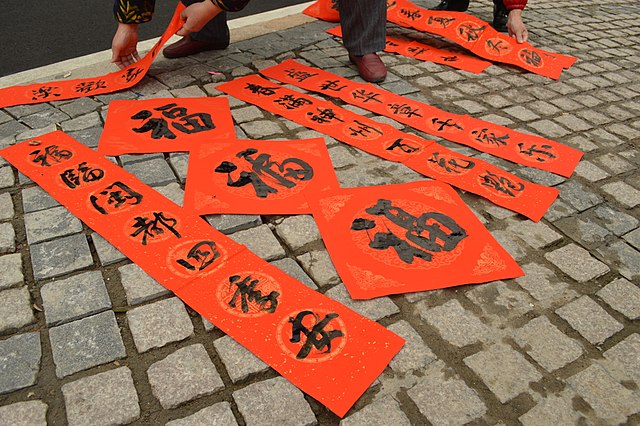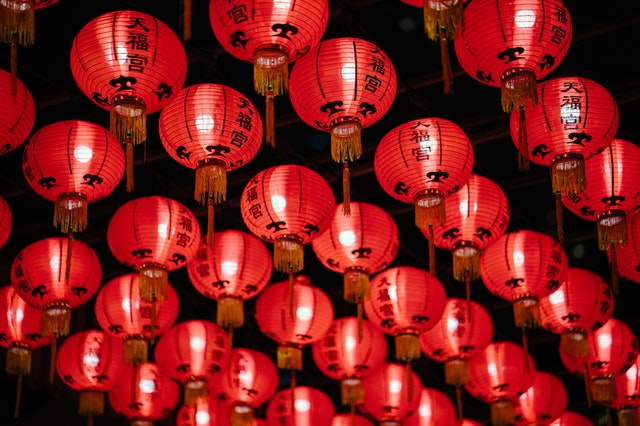The Spring Festival is a celebration full of joyous activities and meaningful Chinese New Year decoration because wherever you are in the world, you are bound to see bright red embellishments representing wishes for blessings and prosperity for the near future. Chinese New Year will update you with trends for Chinese New Year 2021.

People also wear traditional Chinese New Year clothes to exude festive vibes. Below are some of the most popular ornaments used to evoke festive vibes during the occasion.
Contents
Paper Cutting Arts (窗花)
Paper cutting is a folk art that is practiced in many holidays but is most prominent during the Chinese New Year. Literally translates to “window flower,” these artworks can be extremely intricate and are usually seen on windows. Craftsmen paste them using only sticky rice glue. The subjects of these Chinese New Year beautification are often auspicious symbols or phrases.
For instance, fish are puns for blessings, while others like dragons represent Chinese folktales or legends. Images of grains are also crafted to represent hopes of a bountiful harvest.
Door Gods (门神)
Chinese folk religion adheres to many gods and among them are the feisty Door Gods. Images of these powerful warriors are embedded onto the main entrance of the home. The traditional Chinese entrance consists of two doors which is why they are always seen as a pair. Images of the Door Gods are figured after Zhong Kui (钟馗), a popular demon hunter with a terrifying face.
The origin story of the Door Gods dates back to the Tang Dynasty (唐太宗). One night, Emperor Taizong heard howls of demons so he ordered two generals to guard the entrance. The cries of the demons ceased and were never heard again and the emperor honored the generals by pasting their portraits on the door. Although not as popular as in ancient times, some people still place images of the Door Gods on their doors to bring peace and fortune to their homes.
Fortune (福)
Calligraphy is another popular form of art in China. Characters representing blessings are written on square pieces of red paper and pasted on walls, doors, or windows. The most common character used as Chinese New Year beautification is fu (福) as it represents fortune.

People are also inclined to display the character upside down as a play on words. In Chinese, the term for “upside-down” (倒) is a homophone of the Chinese term for “here” (到).
The origin story of this myth involves an emperor who ordered his people to paste the fu character on their doors. However, a family of illiterates mistakenly pasted the character upside down. On New Year’s Day, the emperor sent his troops to see if the people were able to follow his orders. They found the upside-down beautification and condemned the family to death.
Fortunately, the sympathetic empress came up with a clever explanation: because the Chinese terms for “upside-down” and “here” sound alike, the upside-down character should be interpreted as “fortune is here.” The excuse of the empress convinced the emperor to set the illiterate family free. Today, people continue to display the fu character upside down in memory of the kind empress.
Spring Festival Couplets (春联)
Tracing back to over one thousand years ago, Spring Festival couplets have been a staple Chinese New Year beautification for a long time. These couplets were originally carved into tablets made from peach trees until red strips of paper became the mainstream medium.

According to Chinese mythology, there was a giant peach tree that contained a passage for which demons used as an entry to the human world. Two gods guarded this tree. Whenever a demon harmed a human, the gods would punish it by being fed to the tigers.
Frightened by the demons, humans started making tablets out of peach trees and carving the names of the two gods into them. Over time, wooden tablets were replaced by the red strips of paper we continue to see hanged on door frames today. If you are interested in Chinese mythology, check out our list of interesting Chinese New Year myths from our site!
Paintings (年画)
The art of painting has subsisted in China for over one thousand years. Like many Chinese New Year beautification, these paintings often represent wishes of fortune and prosperity for the near future. The use of traditional techniques is still popular today and is integrated with the innovation of printing technology.
Sometimes referred to as encyclopedias of folklife, the concepts of Chinese paintings range from heavenly creatures to everyday contemporary activities. Some of the more common paintings used as Chinese New Year beautification depict either a chubby doll-like child or a beautiful woman. These images express wishes for healthy children and a loving family.
Want to know more about Chinese New Year traditions? Read our articles on Chinese New Year greetings and red envelopes on Chinese New Year.
Kumquats (金桔)
The Cantonese term from kumquat literally translates to “golden tangerine.” These fruits are very popular in the Cantonese-speaking Southern regions of China including Hong Kong.
The Chinese character for “tangerine” (桔) looks similar to the character for “luck” (吉). The golden color of kumquats also symbolizes wealth and fortune. This fruit is a delight on its own or when added to various Chinese New Year desserts. No wonder so many people continue to plant these trees in their front yards!
Lanterns (灯笼)
The Spring Festival celebration lasts for 15 days. To culminate the occasion, the Lantern Festival (元宵) is held on the last day. The styles of these lanterns vary from basic and traditional shapes like spheres and cubes, to complex ones that resemble lotuses and dragons. Some lanterns have Chinese calligraphy and even poetry written on them!

The Kongming Lantern (孔明灯) is especially significant during the festival. People write down their wishes on these lanterns before releasing them to the heavens in hopes of getting their wishes granted. Learn more about the significance of the Chinese Lantern Festival.
The origins of these Chinese New Year decorations date back to thousands of years. Their stories continue to be told today and will continue to be heard in the generations to come!
FAQ
The beautification are put up one week before the New Year. Beautification like Spring Festival Couplets and Fu character pictures are created on the New Year’s eve.
Conclusion
For the beautification, the Chinese people use calligraphy, poetry, plants, and food to express hopes for happiness, good luck, and prosperity. They keep their house full of auspicious symbols which indicate of hope of the family living together and bringing good fortune.
Another popular decorations include the Kumquat trees and auspicious plants like the mandarin oranges ( 桔子 / júzi), which are popular for the same reasons as kumquats, chrysanthemum flowers. Including plum tree and pine tree.
The most popular blooming plants traditionally used during this period are: branches of plum blossoms, orchids, peonies, and peach blossoms which dates down to history. All celebrated for the arrival of spring season. And is one of the most popular festivals in China that involves displaying of Firecrackers during this festivity and various clothing designs with the Chinese Symbol.
Hope you found this article helpful! Your review matters to us, so feel free to comment. We would get in touch with you as soon as possible.
I was an American and raised in Beijing, and I’ve always wondered how China had anything to do with this. I always wondered how this could end up being an attractive way to improve one’s living standards, and how would this result in the average being poorer and even more poorer?